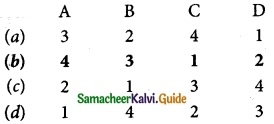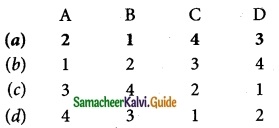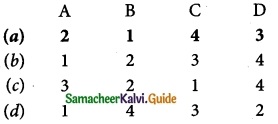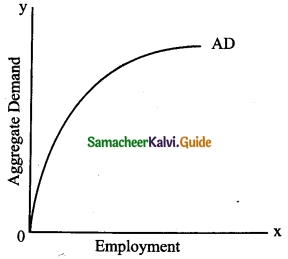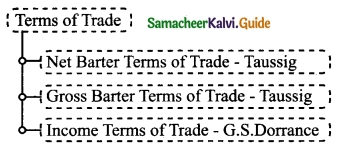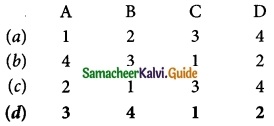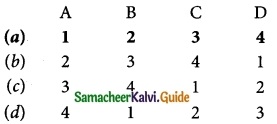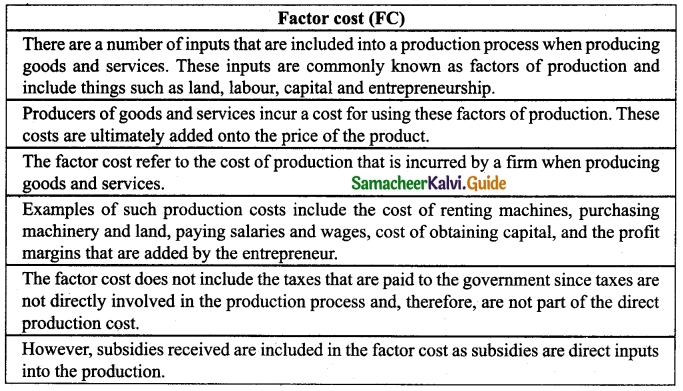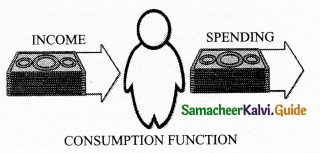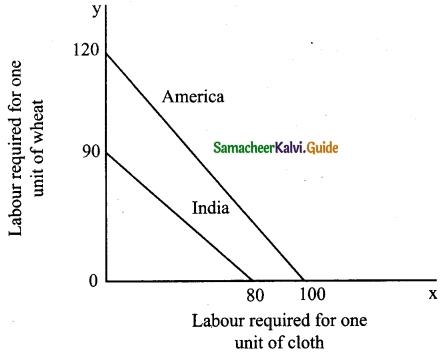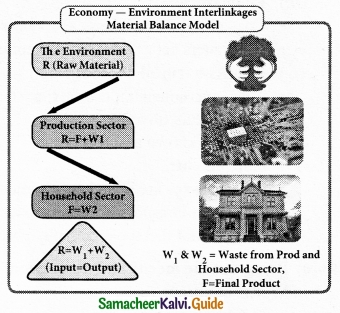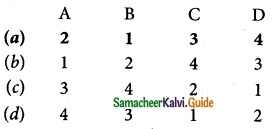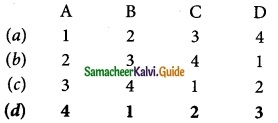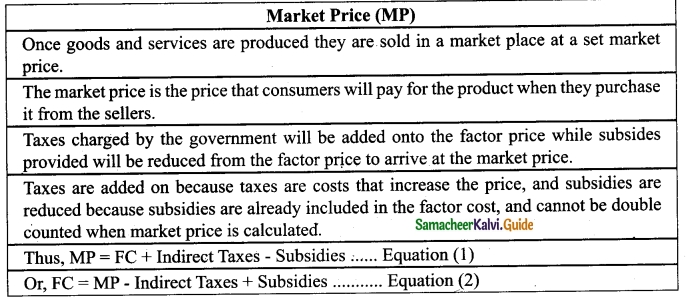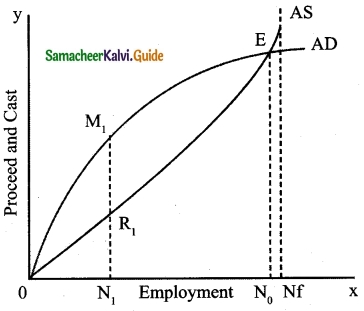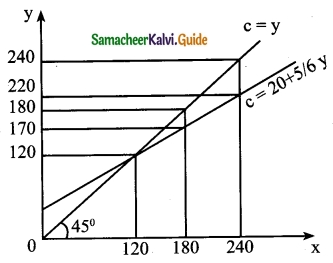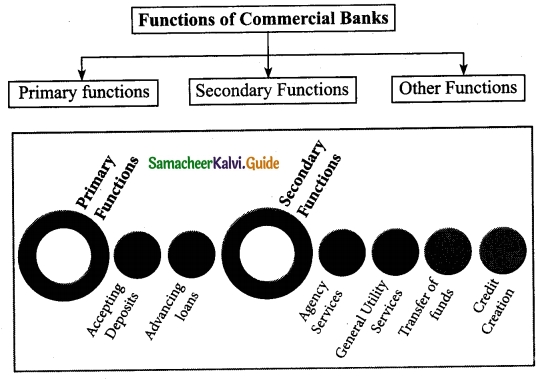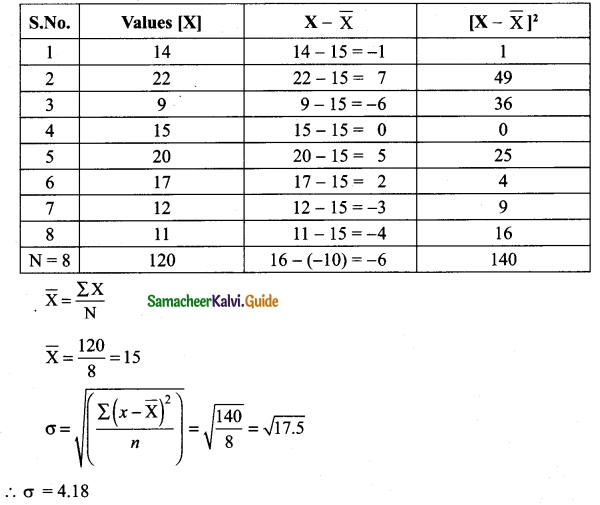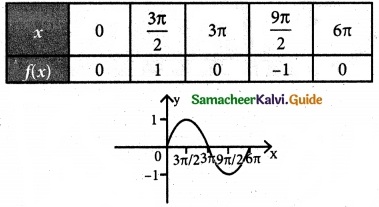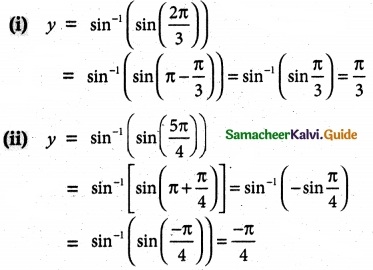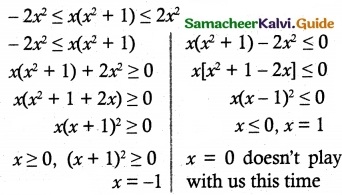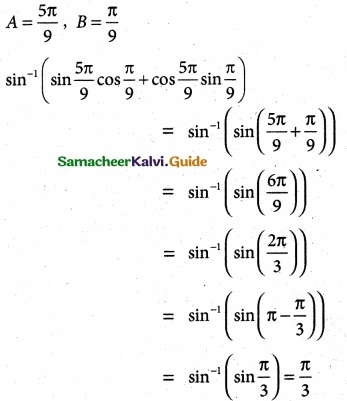Tamilnadu State Board New Syllabus Samacheer Kalvi 12th Tamil Guide Pdf Chapter 1.2 தமிழ்மொழியின் நடை அழகியல் Questions and Answers, Summary, Notes.
Tamilnadu Samacheer Kalvi 12th Tamil Solutions Chapter 1.2 தமிழ்மொழியின் நடை அழகியல்
கற்பவை கற்றபின்
![]()
Question 1.
கவிஞர் பாரதிதாசனின் அழகின்சிரிப்பு – குன்றம் – ஒளியும் குன்றும் பாடலில் இடம்பெற்றுள்ள நடைச்சிறப்பினைத் தொகுத்து உரையாக வழங்குக.
Answer:
ஒளியும் குன்றும்
அருவிகள் வைரத்தொங்கல்
அடர்கொடிப் பச்சைப்பட்டே
குருவிகள் தங்கக் கட்டி
குளிர்மலர் மணியின் குப்பை
எருதின்மேல் பாயும் வேங்கை
நிலவுமேல் எழுந்த மின்னல்
சருகெலாம் ஒளிசேர் தங்கத்
தகடுகள் பாரடா நீ – பாரதிதாசன்
இயற்கை வருணனையைப் பாரதிதாசன் செம்மைப் படுத்துவதில் வல்லவர்.
இப்பாடலில், வானுயிர்ந்த மலையின் அழகை தனக்கே உரித்தான நடையில் உருவகப்படுத்துகிறார்.
- மலையினின்று விழும் வெண்மையான அருவிகள் மலையாகிய பெண்ணின் காதில் அணிந்திருக்கும் வைரத்தாலான தொங்கலாக உள்ளது.
- மலையில் அடர்த்தியாகப் படாந்திருக்கும் பசுமையான கொடிகள் அப்பெண் உடுத்தியிருக்கும் பச்சைப் பட்டாடையாகக் காணப்படுகிறது.
- மலையில் காணப்படும் குருவிகள் சூரிய ஒளியின் காரணமாகக் தங்கக் கட்டிகளாகக் காணப்படுன்றன.
- பூத்திருக்கும் பூக்கள் நவமணிகள் ஆகக் காட்சியளிக்கின்றன.
- எருதின் மேல் பாயும் வேங்கைக் காட்சிகள், முன்வைக்கப்படுகிறது.
- நிலவின் மேல் ஓடுகின்ற மின்னலின் வரிகள் விழுந்து கிடக்கும் சருகுகள் ஒளியின் பிரகாசத்தால் தங்கத்தகடுகளாகக் காட்சியளிக்கின்றன.
Question 2.
தமிழின் சொல்வளத்தை வெளிப்படுத்தும்படியாக யானை / மலர் குறித்த பல சொற்களை அகராதியில் கண்டு பட்டியலிடுக.
Answer:
யானை : வேழம், களிறு, களபம், மாதங்கம், கைம்மா, உம்பர், கரி, தும்பி, ஆனை, களபம், கயமுனி, கைம்மலை, குஞ்சரம், வல்விலங்கு, துங்கல், வாரணம், கடகம், துடியடி, கடகம்.
மலர் : அரும்பு, போது, நளை, முகிழ், புஷ்பம், நறுவி, மெகெகுள், செம்மலர், பொதும்பர், அலர், மகரந்தம், பொம்மல், வீதி.
![]()
பாடநூல் வினாக்கள்
பலவுள் தெரிக
Question 1.
இலக்கியத்தையும் மொழியையும் ஒருசேரப் பேசுகின்ற இலக்கண நூல்
அ) யாப்பருங்கலக்காரிகை
ஆ) தண்டியலங்காரம்
இ) தொல்காப்பியம்
ஈ) நன்னூல்
Answer:
இ) தொல்காப்பியம்
Question 2.
கருத்து 1 : இயல்பு வழக்கில், தொடரமைப்பு என்பது எழுவாய், பயனிலை என்று வருவதே மரபு.
கருத்து 2 : தொடரமைப்பு, சங்கப் பாடல்கள் பலவற்றில் பிறழ்ந்து வருகிறது.
அ) கருத்து 1 சரி
ஆ) கருத்து 2 சரி
இ) இரண்டு கருத்தும் சரி
ஈ) கருத்து 1 சரி 2 தவறு
Answer:
இ) இரண்டு கருத்தும் சரி
Question 3.
பொருத்துக.
அ) தமிழ் அழகியல் – 1. பரலி சு. நெல்லையப்பர்
ஆ) நிலவுப்பூ – 2. தி. சு. நடராசன்
இ) கிடை – 3. சிற்பி பாலசுப்பிரமணியம்
ஈ) உய்யும் வழி – 4. கி. ராஜநாராயணன்
அ) 4, 3, 2,1
ஆ) 1, 4, 2, 3
இ) 2, 4, 1, 3
ஈ) 2, 3, 4, 1
Answer:
ஈ) 2, 3, 4, 1
குறுவினா
Question 1.
நடை அழகியல் பற்றித் தொல்காப்பியம் கூறும் கருத்தைக் குறிப்பிடுக.
Answer:
- நடைபெற்றியலும் (கிளவியாக்கம், 26) என்றும் நடை நவின்றொழுகும் (செய் 135) என்றும் சில சொற்றொடர்களைத் தொல்காப்பியம் கையாண்டிருக்கிறது.
- கவிதையின் இயங்காற்றல்தான் நடை என்கிறது தொல்காப்பியம்.
- மொழிக்குள் இருக்கும் ஒரு வலிமைமிக்க ஆற்றல் கவிதைக்காக, இலக்கியத்துக்காகத் தன்னை வெளிப்படுத்திக் கொள்வதே நடை எனப்படும்.
Question 2.
“படாஅம் ஈத்த கெடாஅ நல்லிசைக்
கடாஅ யானைக் கலிமான் பேக” – இச் சங்கக் கவிதையின் அடிகளில் ஓசை நயமிக்க சொற்களையும் அவற்றிற்கான இலக்கணக் குறிப்புகளையும் எடுத்து எழுதுக.
Answer:
ஓசை நயமிக்கச் சொற்கள் :
படாஅம் ஈத்த, கெடாஅ நல்லிசை, கடாஅயானை, நல்லிசை.
![]()
இலக்கணக் குறிப்புகள் :
படாஅம், கெடாஅ, கடாஅ – செய்யுளிசையளபெடைகள்
ஈத்த – பெயரெச்சம்
நல்லிசை – பண்புத்தொகை
Question 3.
விடியல், வனப்பு – இரு சொற்களையும் ஒருங்கிணைத்துத் தொடர் அமைக்க.
Answer:
பூத்துக் குலுங்கும் பூக்களின் மணத்திலும் பறவைகளின் ஒலிகளிலும் விடியலின் வெளிச்சமாக உதிக்கும் கதிரவனின் தோற்றம் இயற்கையின் வனப்பை எடுத்துரைக்கும்.
சிறுவினா
Question 1.
சங்கப்பாடல்களில் ஒலிக்கோலம் குறிப்பிடத்தக்க ஒரு பண்பாகும் – விளக்குக.
Answer:
- எந்தத் தொன்மையான மொழியும் சமிக்ஞையிலிருந்தும், இசையிலிருந்தும் தான் தோன்றுகிறது.
- சங்கப்பாடல்களில் ஓசையும் பொருளும் இணைந்து கலைவடிவம் கொள்கின்றன.
- இதனையே அந்தப் பனுவல் பாடல்களின் ஒலிப்பின்னல் என்கிறோம். இந்த ஒலிக்கோலங்கள் உணர்ச்சிகளைக் காட்டும் விதமாக அமைக்கப்பட்டுள்ளன.
கடந்தடு தானை மூவிருங் கூடி
உடன்றனிர் ஆயினும் பறம்பு கொளற்கரிதே;
முந்நூறு ஊர்த்தே தண் பறம்பு நன்னாடு;
முந்நூறு ஊரும் பரிசிலர் பெற்றனர்;
உயிர் ஒலிகள் குறிப்பாக நெடில் ஒலிகளின் வருகையும், சில ஒலிகளும் சில சொற்களும் திரும்பவரல் தன்மை பெற்றிருப்பதும், இவற்றோடு சேர்ந்து நிகழ்த்தப்பெறும் சொல் விளையாட்டுகளும் சங்கப்பாடல்களில் ஒலிக்கோலம் குறிப்பிடத்தக்க ஒரு பண்பாக விளங்கியதை உணர்த்தும்.
சான்று : ‘படாஅம் ஈத்த கெடாஅ நல்லிசை கடாஅ யானைக்’ – இவ்வரிகள் ஒலிக்கோலத்தின் பண்பை உணர்த்துகிறது.
![]()
நெடுவினா
Question 1.
கவிதையின் நடையைக் கட்டமைக்கும் அழகியல் கூறுகளை எடுத்துக்காட்டி விளக்குக.
Answer:
கவிதையின் நடையைக் கட்டமைப்பன:
பாட்டு அல்லது நடை அழகியியல் கூறுகளில் ஒலிக்கோலங்களும் சொற்களின் புலமும் தொடரியல் போக்குகளும் முக்கியமானவை.
கவிதை – நடையியல்:
மொழியின் தனிச்சிறப்பான கூறுகளும், அவற்றைக் கையாளுகின்ற வகைமைகளும் கவிதையின் உந்து சக்தியாக அமைகின்றன. மொழிக்குள் இருக்கும் ஒரு வலிமைமிக்க ஆற்றல் கவிதைக்காக, இலக்கியத்துக்காகத் தன்னை வெளிப்படுத்திக் கொள்கிறது. கவிதையின் இயங்காற்றல்தான் நடை. நடைபெற்றியலும் (கிளவியாக்கம் – 26) என்று தொல்காப்பியம் கூறுகிறது.
ஒலிக்கோலங்கள்:
தொன்மையான மொழிகள் யாவும் சமிக்ஞையிலிருந்தும், இசையிலிருந்தும்தான் தொடங்குகிறது. ஓசையும் பொருளும் இணைந்து கலைவடிவம் கொள்கின்றன. இதையே, அந்தப் பனுவலின் – பாடலின் ஒலிப்பின்னல் என்கிறோம்.
சான்று: “கடந்தடு தானை மூவிருங்கூடி உடன்றனிர் ஆயினும் பறம்பு கொளற்கரிதே”
இப்பாடலில் க, த, ட, ற முதலிய வல்லின மெய்கள் பிற மெல்லின் இடையின மெய்களைக் காட்டிலும் அதிகமாக வருகிறது. இதன் அடிப்படையில் ஒப்பிட்டுப் பார்த்து ஒலிக்கோலத்தின் வலிமையை அறியலாம்.
படாஅம் ஈத்த கெடாஅ நல்லிசை
கடாஅ யானைக் கலிமான் பேக (புறம் – 145)
இதில் பல உயிர் ஒலிகள் வருகையும் திரும்பவரல் தன்மையும் இவற்றோடு சேர்ந்து நிகழ்த்தப்பெறும் சொல் விளையாட்டுகளும் இங்கே கவனத்திற்குரியன. ஒலிக்கோலம் சங்கப்பாடல்களின் ஒரு முக்கியப்பண்பு.
சொற்புலம் :
சொல்வளம் என்பது ஒருபொருள் குறித்த பல சொல், பல பொருள் குறித்த ஒரு சொல், பலதுறை, பலசூழல், பல புனைவுகளுக்கும் உரியதாய் வருதலும், உணர்வும், தெளிவும் கொண்டதாய் : 2 வருதலும், எனப் பலவாறு செழிப்பான தளத்தில் சொற்கள் விளைச்சல் கண்டிருப்பதைக் குறிக்கும். சான்றாக, முல்லைக்கலியில் காளைகளில் பல இனங்களைக் காட்டுகின்ற சொற்கள் உள்ளன. சொல்வளம் ஒரு பண்பாட்டின் அடையாளம். சொல்வளம் என்பது தனிச்சொற்களாய் நிறைந்து அமைவதையும் குறிக்கும்.
தொகைநிலை :
சங்க இலக்கிய மொழியின் அடையாளமாக உள்ள ஒரு பண்பு இது. இதனைத் தொகைநிலை என்று தொல்காப்பிய எச்சவியல் பேசுகிறது. தொகைமொழி என்பது செறிவாக்கப்பட்ட ஒரு : வடிவமைப்பு.
அது வாக்கிய அமைப்பில் ஒரு சொல் போலவே நடைபெறும்.
சான்று: வைகுறுவிடியல், கவினுறு வனப்பு, தீநீர் என்பன.
தொடரியல் போக்குகள் :
ஒலிக்கோலமும், சொற்புலமும் சொற்றொடர் நிலையும் பாடலின் தளத்தை ஏர் நடத்திப் பண்படுத்திப் போகின்றன என்றால், பாத்தி கட்டி வரப்புயர்த்தும் பணிகளைத் தொடரியல் வடிவம் செய்கின்றது. பரிமாறப்படும் உணர்வுகளுக்கும் செய்திகளுக்கும் ஏற்பத் தொடர்கள் ஏறியும் இறங்கியும் திரும்பியும் சுழன்றும் இயங்குகின்றன.
கவிதை மறுதலைத்தொடர் :
தொடரமைப்பு என்பது எழுவாய் + செயப்படுபொருள், அல்லது பிறவற்றுடன் கூடிய அமைப்பு + பயனிலை என்று வருவது மரபு. இது சங்கப்பாடல்களில் பலவற்றில் பிறழ்ந்து வருகிறது.
சான்று: பேரெயின் முறுவலாரின், நம்பி நெடுஞ்செழியனுடைய சாவுச்சடங்கு பாடல்
“இடுகவொன்றோ, சுடுகவொன்றோ
படுவழிப்படுக இப்புகழ் வெய்யோன் தலையே” (புறம் – 239)
இதன் இறுதி அடி பிறழ்வோடு அமைந்துள்ளது. ஏனைய 20 அடிகளில் தொடர் வரிசையாகவும் நேர்படவும் செல்கின்றன. ஒவ்வோர் அடியும் வினைமுற்றுகளோடும், தன்னிறைவோடும் முடிகின்றன. இப்படி 18 பண்புகளை வரிசைப்படுத்திய பிறகு, தொகுத்துச் சொல்வதுபோல, : – (ஆங்குச் செய்பவையெல்லாம் செய்தனன் ஆதலின்) கூறிவிட்டுப் போடா போ – புதைத்தால் புதை; சுட்டால் சுடு என்று அலுத்துக் கொள்கிறது.
![]()
இறுதியாக :
நடையியல் என்பது வடிவமைப்பின் பகுதிகளையும் முழுமையினையும் சார்ந்தே இருக்கிறது. அத்தகைய நடை அழகியலைக் கட்டமைப்பதற்குச் சங்க இலக்கியமே முதன்மை ஆதாரம். மேலும் : வ சங்க இலக்கியம் அதனுடைய தனித்துவ மிக்க சமூக – பண்பாட்டுத்தளத்தில் குறிப்பிட்ட சில பண்புகளையும் போக்குகளையும் சொந்த மரபுகளாகக் கொண்டுவிட்டது. எனவே, கவிதையைக் கட்டமைக்கும் அழகியல் கூறுகள் சங்க இலக்கியங்களில் பரவிக் காணப்படுகின்றன.
கூடுதல் வினாக்கள்
பலவுள் தெரிக
Question 1.
செய்யுளை ஓர் உள்ளமைப்பாகக் கூறும் நூல்
அ) நன்னூல்
ஆ) தொல்காப்பியம்
இ) யாப்பருங்கலக்காரிகை
ஈ) தண்டியலங்காரம்
Answer:
ஆ) தொல்காப்பியம்
Question 2.
காளைகளில் பல இனங்களைக் காட்டும் நூல்
அ) தொல்காப்பியம்
ஆ) முல்லைக்கலி
இ) புறநானூறு
ஈ) பதிற்றுப்பத்து
Answer:
ஆ) முல்லைக்கலி
Question 3.
பாடலின் தளத்தைப் பாத்திகட்டி வரப்புயர்த்தும் பணியைச் செய்வது
அ) தொடரியல் வடிவம்
ஆ) ஒலிக்கோலம்
இ) சொற்றொடர் நிலை
ஈ) சொற்புலம்
Answer:
அ) தொடரியல் வடிவம்
![]()
Question 4.
கருத்து 1 : சொல்லில்தான் உணர்வும் பொருளும் பொதிந்து கிடக்கின்றன.
கருத்து 2 : தமிழ் அழகியலைக் கட்டமைப்பதற்குச் சங்க இலக்கியமே முதன்மை ஆதாரம்.
அ) கருத்து 1 சரி
ஆ) கருத்து 2 சரி
இ) கருத்து 1 சரி, 2 தவறு
ஈ) இரண்டு கருத்தும் சரி
Answer:
ஈ) இரண்டு கருத்தும் சரி
Question 5.
கருத்து 1 : முல்லைக்கலியில் எருதுகளின் பல இனங்களைக் காட்டும் சொற்கள் நிரம்பிக் கிடக்கின்றன.
கருத்து 2 : சொல்வளம் ஒரு பண்பாட்டின் அடையாளமாகவும் இருக்கிறது.
அ) கருத்து 1 தவறு
ஆ) கருத்து 1 சரி, 2 தவறு
இ) கருத்து இரண்டும் சரி
ஈ) கருத்து 1 தவறு, 2 சரி
Answer:
இ) கருத்து இரண்டும் சரி
Question 6.
கருத்து : தொன்மையான மொழி சமிக்ஞையிலிருந்தும் இசையிலிருந்தும் தான் தொடங்குகிறது.
விளக்கம் : மொழித்தோன்ற அடிப்படையாக இருப்பது ஒலியே. ஒலியை வெவ்வேறு வடிவங்களில் உச்சரிக்கும் போது மொழித் தோன்றுகிறது.
அ) கருத்து சரி விளக்கம் தவறு
ஆ) கருத்தும் விளக்கமும் சரி
இ) கருத்து தவறு விளக்கமும் தவறு
ஈ) கருத்து தவறு விளக்கம் சரி
Answer:
ஆ) கருத்தும் விளக்கமும் சரி
Question 7.
பொருத்தமானதைக் கண்டறிக.
அ) பாவகை – ஐந்து
ஆ) வஞ்சி – வெண்பா நடைத்தே
இ) பனிநீர் – தொகை மொழி
ஈ) காமர் வனப்பு தொடரியல் போக்கு
Answer:
இ) பனிநீர் – தொகை மொழி
![]()
Question 8.
பொருத்தமானதைக் கண்டறிக.
அ) கடாஅ யானைக் கலிமான் பேக – முல்லைக்கலி
ஆ) புணரின் புணராது பொருளே – தொல்காப்பியம்
இ) இவன் தந்தை தந்தை – நற்றிணை
ஈ) யாமும் பாரியும் உளமே – புறநானூறு
Answer:
ஈ) யாமும் பாரியும் உளமே – புறநானூறு
Question 9.
பொருந்தாததைத் தேர்க.
அ) கன்னி விடியல் – தொகை மொழி
ஆ) பொய்படு சொல் – மறித்தாக்கம்
இ) சங்கப்பாடல்கள் – மறுதலைத் தொடர்
ஈ) கி.ராஜநாராயணன் – கிடை
Answer:
ஆ) பொய்படு சொல் – மறித்தாக்கம்
Question 10.
தமிழ்மொழியின் நடை அழகியல் என்னும் கட்டுரையின் ஆசிரியர்
அ) தி.சு. நடராசன்
ஆ) ஔவை நடராசன்
இ) சிற்பி பாலசுப்பிரமணியம்
ஈ) தமிழண்ண ல்
Answer:
அ) தி.சு. நடராசன்
Question 11.
………….. இழுமெனும் மொழியால் விழுமியது பயக்கும் வகையின் இலக்கியங்கள் படைக்கப்பட்டுள்ளன.
அ) தமிழில்
ஆ) ஆங்கிலத்தில்
இ) தெலுங்கில்
ஈ) வடமொழியில்
Answer:
அ) தமிழில்
Question 12.
மலரும் மணமும் போல கவிதையுடன் இரண்டறக் கலந்திருப்பது
அ) தமிழர்களின் அழகுணர்வு
ஆ) தலைவன் தலைவியின் அன்புணர்வு
இ) வள்ளலின் வள்ளன்மையுணர்வு
ஈ) பக்தர்களின் தெய்வ உணர்வு
Answer:
அ) தமிழர்களின் அழகுணர்வு
Question 13.
அறியப்பட்ட வரலாற்றுக் காலத்தின் தொடக்கமாகத் தோற்றம் தருவது
அ) புராணம்
ஆ) சங்க இலக்கியம்
இ) கல்வெட்டு
ஈ) நாணயம்
Answer:
ஆ) சங்க இலக்கியம்
Question 14.
அழகு என்ப து ……………. செய்தி.
அ) மனிதரின்
ஆ) பேரண்டத்தின்
இ) காதலரின்
ஈ) கடவுளரின்
Answer:
ஆ) பேரண்டத்தின்
![]()
Question 15.
அழகியலை உருவாக்குவதற்குத் தளம் அமைத்துத் தருவது
அ) தொல்காப்பியம்
ஆ) சங்க இலக்கியம்
இ) புராணம்
ஈ) மனிதநடத்தை
Answer:
அ) தொல்காப்பியம்
Question 16.
இலக்கியத்தையும் மொழியையும் ஒருசேரப் பேசுகின்ற இலக்கணம்
அ) தொல்காப்பியம்
ஆ) நன்னூல்
இ) தொன்னூல் விளக்கம்
ஈ) தண்டியலங்காரம்
Answer:
அ) தொல்காப்பியம்
Question 17.
இலக்கியத்தின் ………………. பற்றித் தமிழ் இலக்கிய மரபில் அழுத்தமான கருத்து உண்டு.
அ) நயம்
ஆ) பயன்
இ) நிலை
ஈ) ஈடுபாடு
Answer:
ஆ) பயன்
Question 18.
இலக்கியத்தின் நோக்கம் அல்லது அறிவியல் சார்ந்த கருத்துநிலைகள் கலை உருவாக்கத்தின் போதே சரிவர இணைந்திருக்க வேண்டும் என்று கூறும் நூல்
அ) தொல்காப்பியம்
ஆ) நன்னூல்
இ) இலக்கண விளக்கம்
ஈ) தொன்னூல் விளக்கம்
Answer:
அ) தொல்காப்பியம்
![]()
Question 19.
சங்க இலக்கியம் பாடற்பொருள்களாக வடிவமைத்துள்ளவை
i) அகத்திணைச் சார்ந்த செய்திகள்
ii) புறத்திணைச் சார்ந்த செய்திகள்
அ) i – சரி
ஆ) ii – தவறு
இ) இரண்டும் சரி
ஈ) i – சரி ; ii – தவறு
Answer:
இ) இரண்டும் சரி
Question 20.
அகன் ஐந்திணைகளைப் பேசுவது
அ) நன்னூல்
ஆ) தண்டியலங்காரம்
இ) தொல்காப்பியம்
ஈ) புறப்பொருள் வெண்பாமாலை
Answer:
இ) தொல்காப்பியம்
Question 21.
பா வகைகள் ஆசிரியம் முதற்கொண்டு
அ) மூன்று
ஆ) நான்கு
இ) ஓன்று
ஈ) இரண்டு
Answer:
ஆ) நான்கு
Question 22.
அந்நில மருங்கின் அறமுதலாகிய மும்முதற் பொருட்கும் உரிய என்ப-என்று பாவகைகளோடு அறவியல் கருத்துகளை இணைத்துச்சொல்வது
அ) சங்க இலக்கியம்
ஆ) பரிபாடல்
இ) தொல்காப்பியம்
ஈ) அகத்தியம்
Answer:
இ) தொல்காப்பியம்
![]()
Question 23.
பாட்டு அல்லது கவிதையின் நடையியல் கூறுகளில் முக்கியமானவை
i) ஒலிக்கோலங்கள்
ii) சொற்களின் புலம்
iii) தொடரியல் போக்குகள்
அ) i, ii – சரி
ஆ) ii, iii – சரி
இ) மூன்றும் சரி
ஈ) இரண்டு மட்டும் தவறு
Answer:
இ) மூன்றும் சரி
Question 24.
கவிதையின் ……………. நடை .
அ) இயங்காற்றல்தான்
ஆ) அழகுதான்
இ) பார்வைதான்
ஈ) இயல்புதான்
Answer:
அ) இயங்காற்றல்தான்
Question 25.
‘நடைபெற்றியலும்’ என்பது தொல்காப்பியத்தின் ……….. வரும் சொற்றொடர்.
அ) கிளவியாக்கத்தில்
ஆ) மொழியாக்கத்தில்
இ) எழுத்து அதிகாரத்தில்
ஈ) இவற்றில் எதுவுமில்லை
Answer:
அ) கிளவியாக்கத்தில்
Question 26.
ஆசிரிய நடைத்தே வஞ்சி; ஏனை வெண்பா நடைத்தே கலி-என்று குறிப்பிடும் நூல்
அ) கலித்தொகை
ஆ) தொல்காப்பியம்
இ) பரிபாடல்
ஈ) குறவஞ்சி
Answer:
ஆ) தொல்காப்பியம்
Question 27.
‘கடந்தடுதானை மூவிருங்கூடி’-என்று தொடங்கும் பாடலடிகள் இடம்பெற்றுள்ள நூல்
அ) அகநானூறு
ஆ) புறநானூறு
இ) கலித்தொகை
ஈ) பரிபாடல்
Answer:
ஆ) புறநானூறு
Question 28.
‘படாஅம் ஈத்த கெடாஅ நல்லிசைக் கடாஅயானைக் கலிமான் பேக’ என்னும் அடிகள் இடம்பெற்றுள்ள நூல்
அ) அகநானூறு
ஆ) புறநானூறு
இ) கலித்தொகை
ஈ) பரிபாடல்
Answer:
ஆ) புறநானூறு
![]()
Question 29.
‘புணரின் புணராது பொருளே; பொருள்வயின் பிரியின் புணராது புணர்வே!’ என்னும் அடிகள் இடம்பெற்றுள்ள நூல்
அ) புறநானூறு
ஆ) நற்றிணை
இ) அகநானூறு
ஈ) கலித்தொகை
Answer:
ஆ) நற்றிணை
Question 30.
நுந்தை தந்தைக்கு இவன்தந்தை தந்தை-என்னும் அடிகள் இடம்பெற்றுள்ள நூல்
அ) புறநானூறு
ஆ) நற்றினை
இ) அகநானூறு
ஈ) கலித்தொகை
அ) புறநானூறு
Answer:
அ) புறநானூறு
Question 31.
…………… கலியில், காளைகளில் பல இனங்களைக் காட்டுகிற சொற்கள் நிரம்பிக் கிடக்கின்றன.
அ) குறிஞ்சிக்
ஆ) முல்லைக்
இ) மருதக்
ஈ) பாலைக்
Answer:
ஆ) முல்லைக்
Question 32.
‘கிடை’ என்னும் குறுநாவலில் ஆடுகளின் அடையாளங்களைப் பல பெயர்களைச் சொல்லி அழைப்பவர்
அ) இந்திரா பார்த்தசாரதி
ஆ) கி. ராஜநாராயணன்
இ) ஜெயகாந்தன்
ஈ) ஜெயமோகன்
Answer:
ஆ) கி. ராஜநாராயணன்
![]()
Question 33.
தொகைநிலை, தொகைமொழி பற்றிப் பேசும் தொல்காப்பியத்தின் இயல்
அ) எச்சவியல்
ஆ) இடையியல்
இ) உவமையியல்
ஈ) எழுத்தியல்
Answer:
அ) எச்சவியல்
Question 34.
‘நீர்படு பசுங்கலம்’ என்னும் அடிகளுக்குரிய நூல்
அ) புறநானூறு
ஆ) அகநானூறு
இ) நற்றிணை
ஈ) பரிபாடல்
Answer:
இ) நற்றிணை
Question 35.
நம்பி நெடுஞ்செழியனுடைய சாவுச் சடங்கு, சர்ச்சைக்கு உள்ளானது பற்றிப் பாடியவர்
அ) பேரெயின் முறுவலார்
ஆ) வெள்ளைக்குடி நாகனார்
இ) நரிவெரூஉத்தலையார்
ஈ) கோவூர்கிழார்
Answer:
அ) பேரெயின் முறுவலார்
Question 36.
இடுக வொன்றோ, சுடுக வொன்றோ, படுவழிப் படுக, இப்புகழ் வெய்யோன் தலையே-என்ற புறநானூறு அடிகளில் குறிப்பிடப்படும் மன்னர்
அ) அறிவுடைநம்பி
ஆ) நம்பி நெடுஞ்செழியன்
இ) செங்குட்டுவன்
ஈ) கிள்ளிவளவன்
Answer:
ஆ) நம்பி நெடுஞ்செழியன்
Question 37.
‘தொடியுடைய தோள் மணந்தனன்’ எனத் தொடங்கும் புறநானூற்றுப் பாடலின் ஆசிரியர்
அ) பேரெயின் முறுவலார்
ஆ) பொன்முடியார்
இ) கோவூர்கிழார்
ஈ) வெள்ளைக்குடி நாகனார்
Answer:
அ) பேரெயின் முறுவலார்
Question 38.
பேரெயின் முறுவலாரின் புறநானூற்றுப் பாடலில் இடம்பெற்றுள்ள பண்புகள்
அ) 16
ஆ) 18
இ) 15
ஈ) 14
Answer:
ஆ) 18
Question 39.
தமிழ் அழகியலைக் கட்டமைப்பதற்குச் ……………. முதன்மை ஆதாரம்.
அ) சங்க இலக்கியமே
ஆ) சங்கம் மருவிய இலக்கியமே
இ) நீதி இலக்கியமே
ஈ) காப்பியமே
Answer:
அ) சங்க இலக்கியமே
![]()
Question 40.
தமிழ் அழகியல் என்னும் நூலின் ஆசிரியர்
அ) தி.சு. நடராசன்
ஆ) ஔவை நடராசன்
இ) தமிழண்ண ல்
ஈ) வல்லிக்கண்ணன்
Answer:
அ) தி.சு. நடராசன்
Question 41.
…………. கலையைத் தமிழக்கு அறிமுகப்படுத்தியவர்களில் தி. சு. நடராசன் குறிப்பிடத்தக்கவர்.
அ) திரைக்
ஆ) திறனாய்வுக்
இ) மொழிபெயர்ப்புக்
ஈ) பேச்சுக்
Answer:
ஆ) திறனாய்வுக்
Question 42.
தி.சு. நடராசன் …………. ஆகப் பணிபுரிந்தார்.
அ) மாவட்ட ஆட்சியர்
ஆ) போராசிரியர்
இ) வழக்குரைஞர்
ஈ) மருத்துவர்
Answer:
ஆ) போராசிரியர்
குறுவினா
Question 1.
இலக்கியம் எவற்றைத் தனக்குரிய அழகியல் சாதனமாக மாற்ற வேண்டியுள்ளது?
Answer:
மனித நாக்குகளின் ஈரம்பட்டுக் கிடக்கும் மொழியானது, பேசுபவன், கேட்பவன் ஆகியோருடைய தனிப்பட்ட சூழல்கள் பேசும் போதும், கேட்கும் போதும் தனிச்சூழல்களைத் தனக்குரிய அழகியல் சாதனமாக மாற்ற வேண்டும்.
Question 2.
மொழியின் சிறப்பு வழக்குகளைக் கலையியல் வழக்குகளாக மாற்றுபவை எவை?
Answer:
உவமம், உருவகம், எச்சம், குறிப்பு , உள்ளுறை, இறைச்சி முதலியவை மொழியின் இயல்பு வழக்குகளைக் கலையியல் வழக்குகளாக மாற்றுபவையாகும்.
Question 3.
தமிழ் இலக்கியத்தின் பயன்களாகக் கட்டுரையாசிரியர் கூறுவன யாவை?
Answer:
அறம், பொருள், இன்பம் அல்லது வேறு ஏதோ ஓர் உயர்ந்த குறிக்கோளை உணர்த்துவனவாக தமிழ் இலக்கியத்தின் பயன்கள் இருக்க வேண்டும்.
Question 4.
‘கலை முழுமை’ பற்றித் தொல்காப்பியம் குறிப்பிடுவது யாது?
Answer:
‘கலை முழுமை’, என்பது இலக்கியத்திற்கான நோக்கம் அல்லது அறிவியல் சார்ந்த கருத்துநிலைகள், கலை உருவாக்கத்தின் போதே சரிவர இணைந்திருக்க வேண்டும் என்று தொல்காப்பியம் குறிப்பிடுகின்றது.
Question 5.
தமிழ் அழகியலின் நெடும்பரப்புகளென ஆசிரியர் எதனைக் குறிப்பிடுகிறார்?
Answer:
சமூக பண்பாட்டு மரபிற்கேற்பவே, கலை படைப்பை, அழகியல் நெறியை, பண்பாட்டின் இலச்சினையாகச் சித்தரிப்பதற்குத் தமிழ்மரபு முன்வந்திருக்கிறது; முன் மொழிந்திருக்கிறது. இதுவே தமிழ் அழகியலின் நெடும்பரப்பு ஆகும்.
Question 6.
பாடலின் தளத்தை ஏர் நடத்திப் பண்படுத்திப் போகின்றனவை எவை?
Answer:
ஒலிக்கோலம், சொற்புலம், சொற்றொடர் நிலை.
![]()
Question 7.
பண்டைய கவிஞர்களுக்கு இயல்பாக இருந்த உணர்வு எது?
Answer:
கவிப்பொருளை அமைக்கின்ற விதத்தில் உணர்ச்சிகளைப் பாய்ச்சும் விதத்தில் தீங்கவிகளைச் செவியாரப் பருகச்செய்து கற்போர் இதயம் கனியும் வண்ணம் படைக்கும் அழவியல் உணர்வு, பண்டைக் கவிஞர்களுக்கு இயல்பாக இருந்தது.
Question 8.
இலக்கியத்தனம் என்பது யாது?
Answer:
- இலக்கியம் என்ற மொழிசார்கலை, மொழியின் தனித்துவமான பண்புகளை இயன்ற மட்டும் தனக்குரியதாக்கிக் கொள்கிறது.
- இலக்கியத்திற்கு ஒரு சிறப்புத்தன்மையைத் தந்துவிடுகிறது. இத்தகைய தன்மைதான் கவித்தனம் அல்லது இலக்கியத்தனம் என்று பேசப்படுகிறது.
Question 9.
மொழியின் வழக்குகளைக் கலையியல் வழக்குகளாக மாற்றுபவை எவை?
Answer:
உவமம், உருவகம், எச்சம், குறிப்பு, உள்ளுறை, இறைச்சி.
Question 10.
‘லட்சியம்’ பொருள்களோடு இரண்டற இணைத்துவிடுவது எது?
Answer:
அகன் ஐந்திணைகளைப் பேசுகிற தொல்காப்பியம் புணர்தல், பிரிதல் முதலான அகன் ஐந்தினைகளை இன்பம், பொருள், அறம் ஆகிய அறவியல் ‘லட்சியப் பொருள்களோடு இரண்டற இணைத்துவிடுகிறது.
Question 11.
எந்த தொன்மையான மொழியும் எவற்றிலிருந்து தொடங்குகிறது?
Answer:
எந்த தொன்மையான மொழியும் சமிக்கையிலிருந்தும் இசையிலிருந்தும்தான் தொடங்குகிறது.
![]()
Question 12.
ஒலிப்பின்னல் என்பது யாது?
Answer:
- மொழிசார்ந்த கவிதையும் இசையோடும் இசைக்கருவியோடும்தான் பிறக்கிறது.
- ஓசையும் பொருளும் இணைந்து கலைவடிவம் கொள்கின்றன.
- இதனையே அந்தப் பனுவலின் பாடலின் ஒலிப்பின்னல் என்கிறோம்.
Question 13.
சொல்லில் புதைந்து கிடப்பன யாவை?
Answer:
- சொல்லில்தான் உணர்வும் பொருளும் பொதிந்து கிடக்கின்றன.
- கலையும் பண்பாடும் வரலாறும் அரசியலும் பொதிந்து கிடக்கின்றன.
Question 14.
தமிழ் இலக்கியங்களில் காணப்படும் சொல்வளத்திற்கான சான்றுகளைத் தருக.
Answer:
- முல்லைக் கலியில், காளைகளில் பல இனங்களைக் காட்டுகிற சொற்கள் நிரம்பிக் கிடக்கின்றன.
- கி. ராஜநாராயணன் ‘கிடை’ என்னும் குறுநாவலில் ஆடுகளில் அடையாளங்களைப் பல பெயர்கள் சொல்லி அழைக்கிறார்.
Question 15.
சொல்வளம் என்பது யாது?
Answer:
- சொல்வளம் என்பது தனிச்சொற்களாய் நிறைந்து அமைவதையும் குறிக்கும்.
- ஒன்றிற்கு மேற்பட்ட சொற்கள் கவவுக்கை நெகிழாமல் முயங்கிக் கிடப்பதையும் குறிக்கும்.
Question 16.
தொடரியில் வடிவம் செய்யும் பணிகள் யாவை?
Answer:
ஒலிக்கோலமும் சொற்புலமும் சொற்றொடர் நிலையும் பாடலின் தளத்தை ஏர் நடத்திப் பண்படுத்திப் 11 போகின்றன என்றால், பாத்திகட்டி வரப்புயர்த்தும் பணிகளைத் தொடரியல் வடிவம் செய்கின்றது.
![]()
Question 17.
தி. சு. நடராசன் தமிழ்ப் போராசிரியராகப் பணியாற்றிய பல்கலைக்கழகங்களைக் கூறுக.
Answer:
- மதுலை காமராசர் பல்கலைக்கழகம்.
- போலந்து நாட்டின் வார்ஸா பல்கலைக்கழகம்.
- திருநெல்வேலி மனோன்மணியம் சுந்தரனார் பல்கலைக்கழகம்.
Question 18.
தி.சு. நடராசன் இயற்றிய நூல்கள் யாவை?
Answer:
கவிதையெனும் மொழி, திறனாய்வுக்கலை, தமிழ் அழகியல், தமிழின் பண்பாட்டு வெளிகள்.
சிறுவினா
Question 1.
தி.சு. நடராசன் – குறிப்பு வரைக.
Answer:
பெயர் : தி.சு. நடராசன்
சிறப்பு : திறனாய்வுக்கலையைத் தமிழுக்கு அறிமுகப்படுத்தியவர்.
பதவி : மதுரை காமராசர் பல்கலைக்கழகம், போலந்து நாட்டின் வார்சா பல்கலைக்கழகம், திருநேல்வேலி மனோன்மணீயம் சுந்தரனார் பல்கலைக்கழகம் ஆகியவற்றில் தமிழ்ப் பேராசிரியராகப் பணிபுரிந்தார்.
படைப்புகள் : கவிதையெனும் மொழி, தமிழ் அழகியல், தமிழ் பண்பாட்டு வெளிகள், திறனாய்வுக்கலை.
Question 2.
சங்கப்பாடல்கள் பலவற்றுள் அமைந்துள்ள மறுதலைத் தொடரியல் போக்குக்குச் சான்று தந்து விளக்குக.
Answer:
தமிழ் மொழியில் உரைநடை வழக்கு, பேச்சு வழக்கு உள்ளிட்ட இயல்பு வழக்கில் தொடரமைப்பு என்பது எழுவாய் + செயப்படுபொருள் அல்லது பிறவற்றுடன் கூடிய அமைப்பு + பயனிலை என்று வருவதே மரபு. ஆனால் சங்கப்பாடல்கள் பலவற்றில் இந்நிலை மாறி வருகிறது. இதனைக் கவிதை மறுதலைத் தொடர் என்பர்.
சிறப்பாக முடியும் பாடல்களின் இறுதியில்தான் இந்தத் தொடரியல் பிறழ்வுநிலை பெரிதும் காணப்படுகிறது. எடுத்துக்காட்டாகப் பேரெயின் முறுவலார், நம்பி நெடுஞ்செழியனுடைய சாவுச் சடங்கில் முரண்பாடான கருத்து உருவாகியுள்ளதை
இடுக வொன்றோ, சுடுகவொன்றோ;
படுவழிப் படுக, இப்புகழ் வெய்யோன் தலையே! (புறம் : 239)
என்ற இப்பாடலில் இடம் பெற்றுள்ள இறுதி அடி ஓர் எளிமையான தொடரியல் பிறழ்வோடு அமைந்திருக்கிறது.
![]()
‘தொடியடைய தோள் மணந்தனன்’ எனத் தொடங்கும் இப்பாடலில் தொடர்ந்து வரும் 20 அடிகளில் தொடர்கள் வரிசையாகவும் நேர்படவும் செல்வதைக் காணலாம். ஒவ்வோர் அடியிலும் தனித்தனியே வினைமுற்றுகளோடு தன்னிறைவோடு 18 பண்புகளை வரிசைப்படுத்தித் தொகுத்துக் : ல கூறும் புலவர் இறுதியில் நெடுஞ்செழியனுடைய உடலைப் புதைத்தால் புதை ; சுட்டால் சுடு என்று அலுத்துக் கொள்கிறார். இது சங்கப் பாடலின் மறுதலைத் தொடரியல் போக்குக்குத் தகுந்த சான்றாகும்.





